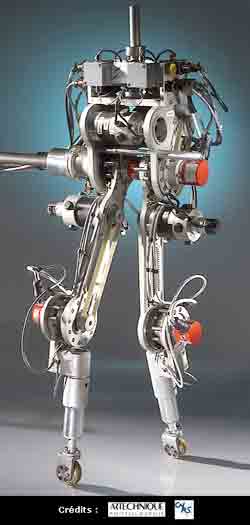Robot walks, balances like a human

If you nudge this robot, it steps forward and catches its balance—much like a human
The machine called RABBIT, which resembles a high-tech Tin Man from “The Wizard of Oz,” minus the arms, was developed by University of Michigan and French scientists over six years. It’s the first known robot to walk and balance like a human, and late last year, researchers succeeded in making RABBIT run for six steps. It has been able to walk gracefully for the past 18 months.
U-M researcher Jessy Grizzle, who developed the control theory for the robot, said that the balancing ability programmed into the robot has many applications in the medical field, such as so-called smart prosthetics that adapt to the wearer, and physical rehabilitation aids to help people regain the ability to walk.
Bipedal robots—or two-legged walking machines—in existence today walk flat-footed, with an unnatural crouching or stomping gait, said Grizzle, professor of electrical engineering and computer science.
Up until RABBIT, scientists produced stability in two-legged walking machines largely through extensive trial and error experiments during development, Grizzle said. Current walking machines use large feet to avoid tipping over and do not require the robot’s control system to be endowed with a real understanding of the mechanics of walking or balance, Grizzle said. If you provided these robots with a pair of stilts or asked them to tip-toe across the room, they would just fall over.
RABBIT was built without feet. Its legs end like stilts so that it pivots on a point when it moves forward. “If you build a robot that pivots on a point you must understand how the different parts interact dynamically, or else it will fall over,” Grizzle said. If a robot has no feet, it’s impossible to “cheat.”
The U-M/French control theory for walking, which was published in a recent paper in the International Journal of Robotics Research, gives scientists an analytical method that can predict in advance how the robot will move, Grizzle said.
“The concept of stability is reduced to two formulas,” Grizzle said. “It’s a matter of understanding enough about the dynamics of walking and balance so that you can express with mathematical formulas how you want the robot to move, and then automatically produce the control algorithm that will induce the desired walking motion on the very fist try.”
Grizzle’s work has promising applications in designing human prosthetics.
“Our analytic method is very cost effective by reducing the amount of experimental work that goes into motion design,” Grizzle said. “If you can take properties of a patient, their height, weight, how the valid leg functions, etc., maybe you could more quickly have the prosthetic adapt its characteristics to the person, instead of the person adapting his gait to the prosthetic—which is essentially what happens now. These things are dreams, we’re not there yet. But you need principles to get there.”
Other applications include rehabilitative walking aids for spinal injury patients, machines designed for home use that can climb stairs or robots for use in exploratory missions over rough terrain.
RABBIT is part of France’s ROBEA project (Robotics and Artificial Entity), which involves seven laboratories and researchers in mechanics, robots and control theory. The machine is housed in France’s Laboratoire Automatique de Grenoble,
Video of RABBIT shot by researchers during experiments shows a pair of mechanical legs walking in a circle while attached to a boom that keeps it from falling over sideways but does not guide or control its forward momentum. When pushed from behind by researcher Eric Westervelt, formerly a student of Grizzle’s and now an assistant professor of mechanical engineering at Ohio State University, RABBIT lurches forward, then rights itself and continues its even forward stride.
U-M became involved in the research in 1998, when Grizzle met with the lead researcher on the ROBEA project while on sabbatical in Strasbourg, France. Grizzle was able to bring his expertise in control theory, something the researchers designing the robot in Strasbourg were without.
Media Contact
All latest news from the category: Power and Electrical Engineering
This topic covers issues related to energy generation, conversion, transportation and consumption and how the industry is addressing the challenge of energy efficiency in general.
innovations-report provides in-depth and informative reports and articles on subjects ranging from wind energy, fuel cell technology, solar energy, geothermal energy, petroleum, gas, nuclear engineering, alternative energy and energy efficiency to fusion, hydrogen and superconductor technologies.
Newest articles

NASA: Mystery of life’s handedness deepens
The mystery of why life uses molecules with specific orientations has deepened with a NASA-funded discovery that RNA — a key molecule thought to have potentially held the instructions for…

What are the effects of historic lithium mining on water quality?
Study reveals low levels of common contaminants but high levels of other elements in waters associated with an abandoned lithium mine. Lithium ore and mining waste from a historic lithium…

Quantum-inspired design boosts efficiency of heat-to-electricity conversion
Rice engineers take unconventional route to improving thermophotovoltaic systems. Researchers at Rice University have found a new way to improve a key element of thermophotovoltaic (TPV) systems, which convert heat…



